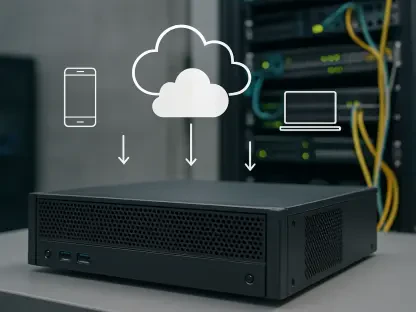Unveiling a Hidden Threat in Network Security
In an era where network infrastructure forms the backbone of global connectivity, a staggering reality emerges: critical devices managing vast data flows are under siege by sophisticated cyberattacks, posing severe risks to organizations worldwide. A recently uncovered campaign exploiting a vulnerability in Cisco’s Simple Network Management Protocol (SNMP), identified as CVE-2025-20352, has sent shockwaves through the cybersecurity community. This exploit targets a range of Cisco devices, exposing them to remote code execution and persistent unauthorized access, raising urgent questions about the security of foundational network technology.
This review delves into the intricate mechanics of this exploit, dissecting its technical components and the broader implications for network security. By exploring the stealthy tactics employed by attackers, the affected systems, and the challenges in mitigation, a clearer picture emerges of the risks facing organizations reliant on Cisco infrastructure. The focus here is to evaluate the severity of this vulnerability and the effectiveness of current defenses against such advanced threats.
In-Depth Analysis of the Exploit Mechanics
Unpacking the SNMP Flaw and Remote Code Execution
At the heart of this cyberattack lies CVE-2025-20352, a critical flaw in Cisco’s SNMP implementation that enables attackers to execute arbitrary code remotely on vulnerable devices. Specific models like the 9400, 9300, and older 3750G series are prime targets, with attackers crafting distinct exploit variants for 32-bit and 64-bit architectures. On 32-bit systems, command payloads are fragmented across packets, a tactic designed to bypass basic security checks and execute malicious instructions seamlessly.
The precision of this exploit underscores a deep understanding of Cisco’s internal architecture by the attackers. By leveraging the SNMP protocol, typically used for network monitoring, malicious actors gain a foothold to run unauthorized commands. This breach of trust in a fundamental protocol reveals a significant gap in network device security, exposing how even routine management tools can become entry points for catastrophic breaches.
Telnet Flaw Synergy and Memory Manipulation Tactics
Compounding the danger, the campaign integrates a modified Telnet vulnerability, derived from a previously known issue tracked as CVE-2017-3881, to manipulate device memory directly. This secondary exploit allows attackers to access sensitive areas of a device’s memory, paving the way for installing fileless backdoors that leave no trace on disk. Such techniques are particularly insidious, as they evade traditional file-based detection methods.
On 64-bit systems, the attack escalates further by exploiting guest shell access at privilege level 15, embedding persistent backdoors without physical footprints. This memory-based approach ensures that even after a device reboot, the compromised state can be reestablished through remote triggers. The combination of SNMP and Telnet flaws creates a dual-pronged attack vector, amplifying the potential for long-term compromise of critical network assets.
Stealth and Power of the Linux Rootkit
The deployed Linux rootkit in this campaign stands out for its covert capabilities, designed to maintain control while avoiding detection. Acting as a UDP listener, it enables remote command execution, allowing attackers to issue instructions without direct interaction. Additionally, the rootkit manipulates IOSd memory to create universal passwords—referred to by the codename “disco”—and hides critical configuration details such as account names and access control lists.
Beyond mere persistence, this rootkit bypasses security restrictions and alters device logs to cover its tracks. Such stealth features make it extraordinarily difficult for network administrators to identify an intrusion without specialized tools. The ability to operate undetected within the core of network infrastructure highlights a new frontier in cyber threats, where attackers prioritize invisibility over immediate destruction.
Performance Impact and Systemic Risks
Targeting Legacy Systems and Network Weaknesses
A notable trend in this attack campaign is the deliberate focus on outdated network infrastructure, particularly Cisco devices with default SNMP community strings, enabled Telnet, or accessible guest shell environments. Older Linux hosts, often lacking modern endpoint detection and response (EDR) systems, are primary targets, as they provide fertile ground for fileless malware to operate unnoticed. This preference for legacy systems exposes a persistent vulnerability in many organizations’ networks.
The impact extends beyond individual devices, as compromised systems facilitate lateral movement within networks. Once a single device is breached, attackers can pivot to other critical systems, potentially accessing sensitive data or disrupting operations. This cascading risk underscores the importance of securing every node in a network, especially those running on aging hardware or software that may no longer receive regular updates.
Real-World Consequences Across Industries
The real-world implications of this vulnerability are profound, especially for sectors reliant on Cisco infrastructure, such as telecommunications, energy, and government services. Affected models, including the widely used 9400 and 9300 series, are integral to managing data traffic in critical environments. A breach in these systems could lead to service outages, data theft, or even manipulation of operational controls in worst-case scenarios.
Reports indicate that the campaign has already impacted numerous organizations, particularly those with insufficient monitoring of legacy equipment. The absence of automated detection tools exacerbates the issue, leaving many entities unaware of their compromised status. This gap in visibility poses a systemic risk, as undetected breaches could serve as entry points for broader cyberattacks over time.
Challenges and Mitigation Strategies
Detection Hurdles in a Stealth-Driven Attack
Detecting this exploit remains a significant challenge due to the lack of universal automated testing solutions. Both industry experts and Cisco acknowledge that current security tools are ill-equipped to identify the subtle, memory-based alterations caused by this rootkit. Organizations suspecting a breach must resort to manual firmware and ROM analysis through Cisco’s Technical Assistance Center, a process that is both time-intensive and resource-heavy.
The stealthy nature of fileless techniques further complicates detection efforts. Traditional antivirus and intrusion detection systems, which rely on file signatures or behavioral patterns, often fail to flag memory-based threats that disappear after reboots. This limitation highlights a critical need for advanced monitoring solutions tailored to network devices rather than just endpoint systems.
Recommended Defenses and Security Enhancements
To counter this threat, immediate mitigation steps are essential. Applying Cisco’s patches and firmware updates should be a priority for all affected device owners, alongside disabling unnecessary services like SNMP and Telnet where feasible. Restricting management access to trusted networks or bastion hosts adds another layer of protection, minimizing exposure to external threats.
Beyond reactive measures, deploying EDR solutions on Linux-based systems and implementing strong access control lists can bolster defenses. Enabling features like Address Space Layout Randomization, where supported, adds unpredictability to memory allocation, making exploitation more difficult. These proactive steps, combined with regular security audits, are crucial for safeguarding network infrastructure against evolving attack methodologies.
Reflecting on a Persistent Threat and Path Forward
Looking back, the campaign exploiting Cisco’s SNMP vulnerability revealed a sobering reality about the state of network security. The technical sophistication of the exploit, paired with the stealth of the Linux rootkit, exposed deep vulnerabilities in widely used infrastructure. It became evident that legacy systems, often overlooked in modernization efforts, remained a glaring weak spot for many organizations.
Moving forward, the cybersecurity community must prioritize the development of automated detection tools capable of identifying memory-based threats in real time. Collaboration between vendors like Cisco and research entities should focus on creating firmware updates that address not only current exploits but also potential future variants. Phasing out outdated devices, while challenging, emerged as a necessary long-term goal to reduce attack surfaces.
Ultimately, organizations were urged to adopt a multi-layered security posture, integrating advanced monitoring, strict access controls, and regular system updates. Investing in training for network administrators to recognize and respond to subtle signs of compromise also proved vital. As cyber threats continue to evolve, proactive adaptation and vigilance stand as the best defenses against persistent, stealth-driven attacks on critical network infrastructure.









